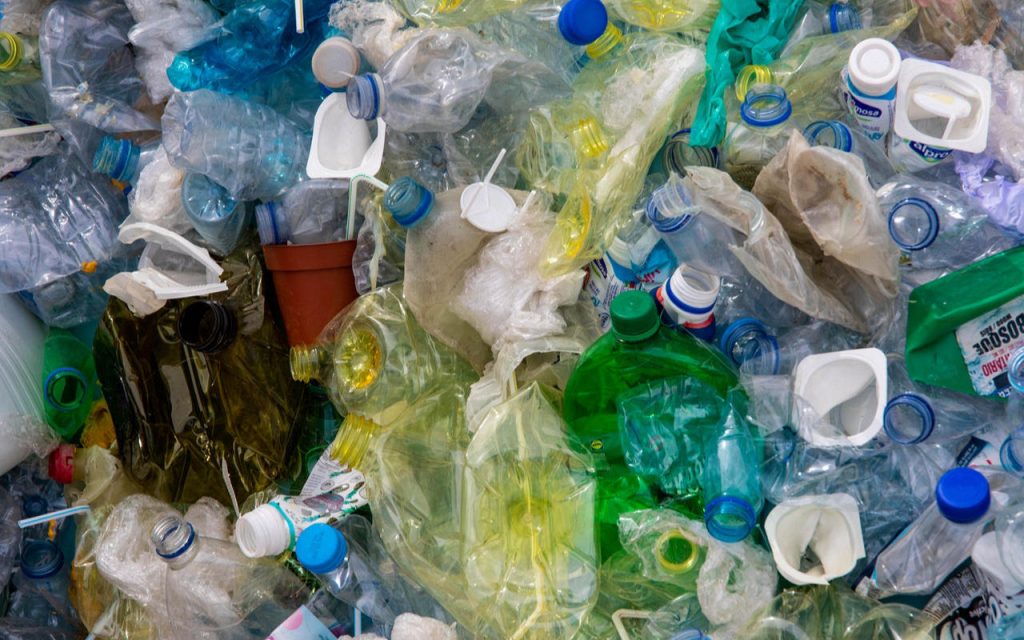Plastic packaging recycling starts at the end – when a bag, sheet, bubble package or bottle has served its purpose, and needs to be discarded.
Like any other person willing to do their bit for the planet, you probably have a recycling bin at home, where all your plastic packaging goes – along with all your paper, cans and card, too. In the business world, industrial and commercial recycling bins are usually split; one for card and one for plastic.
But this basic sorting is just the beginning of a long process. How is plastic packaging recycled, and what does it turn into?

Sorting and processing for plastic packaging recycling
One of the biggest steps in recycling plastic packaging is sorting.
Not all plastics are the same. Some are dyed, some have chemical additives, and some are made of different materials altogether. Some plastics can’t yet be effectively recycled at all. So, after collection, plastics are sorted by colour as well as type at the recycling facility. This is a semi-automated but still labour-intensive process.
But even though it’s demanding, sorting is vital – because some types of plastic packaging (like HDPE) are denser than others (like LDPE). If they were melted and combined, one would “float” on top of the other – just like oil floats on water. The blend wouldn’t be stable and would disintegrate, making it useless.
Read more: Is polythene recyclable?
After sorting, each type of plastic is shredded up. Any impurities like paper labels, glue and leftovers of the packaged product are washed out. Once it’s as pure as it can be, the shredded plastic is then melted down into a thick, jam-like, almost liquid state. This plastic “jam” gets forced through a mould, which produces pellets of recycled plastic. These pellets will be used as the material for new plastic products or packaging.
Grades of recycled material
There’s a fair amount to unpack on this subject, because plastic degrades as it’s recycled. So, for simplicity’s sake, let’s cover the two main types of recycled material: pre-consumer and post-consumer.
- Pre-consumer recycled material is made from manufacturer waste: scraps, trimmings or a product that hasn’t passed QA, but the material is still good to use. It can also come from industrial or commercial sources, where it may only have been used in logistics and is still pure.
- Post-consumer recycled materials are made from waste that has been used, disposed of, and diverted from landfills into a recycling program. For example – a plastic drinks bottle.
Generally, pre-consumer recycled material is used in recycled plastic packaging. It’s purer, cleaner and easier to sort. Eventually though, all plastic packaging will become post-consumer.
Post-consumer recycled plastic packaging can only be made into packaging again one time. After that, it loses integrity and tends to go into clothing, outdoor toys and furniture, car parts and other long-life goods. Purity and integrity aren’t as important in these applications.
Are there any types of plastic that cannot be recycled?
Yes. Again, there’s quite a lot to it – so to keep it simple, let’s cover the two main classes of plastic you’ve likely encountered: thermosetting plastics and thermoplastics.
Currently, thermosetting plastics cannot be recycled efficiently. That’s because they’re chemically cured after moulding, which makes them extremely strong, shiny and hard wearing. But it also means they don’t melt well – so it’s too difficult to turn them into new products. This is the kind of plastic that plug sockets, double glazed windows, tools and most large consumer electronic goods are made of.
Thermoplastics on the other hand respond well to heating and melt predictably – meaning they can be recycled into new packaging and products at least once before they degrade.
While by no means perfect, recycling is still the best solution for packaging. One day, technology will close the loop on plastic production, giving us infinitely recyclable plastic. But until then, let’s keep sorting our recycling out and doing our bit to cut waste.
Buy Recyclable Plastic Packaging – Help Cut Waste
Our recyclable packaging products help you cut down on waste. Call our friendly team on 01773 820415 for advice and help with your recyclable packaging, or get a quote now.


